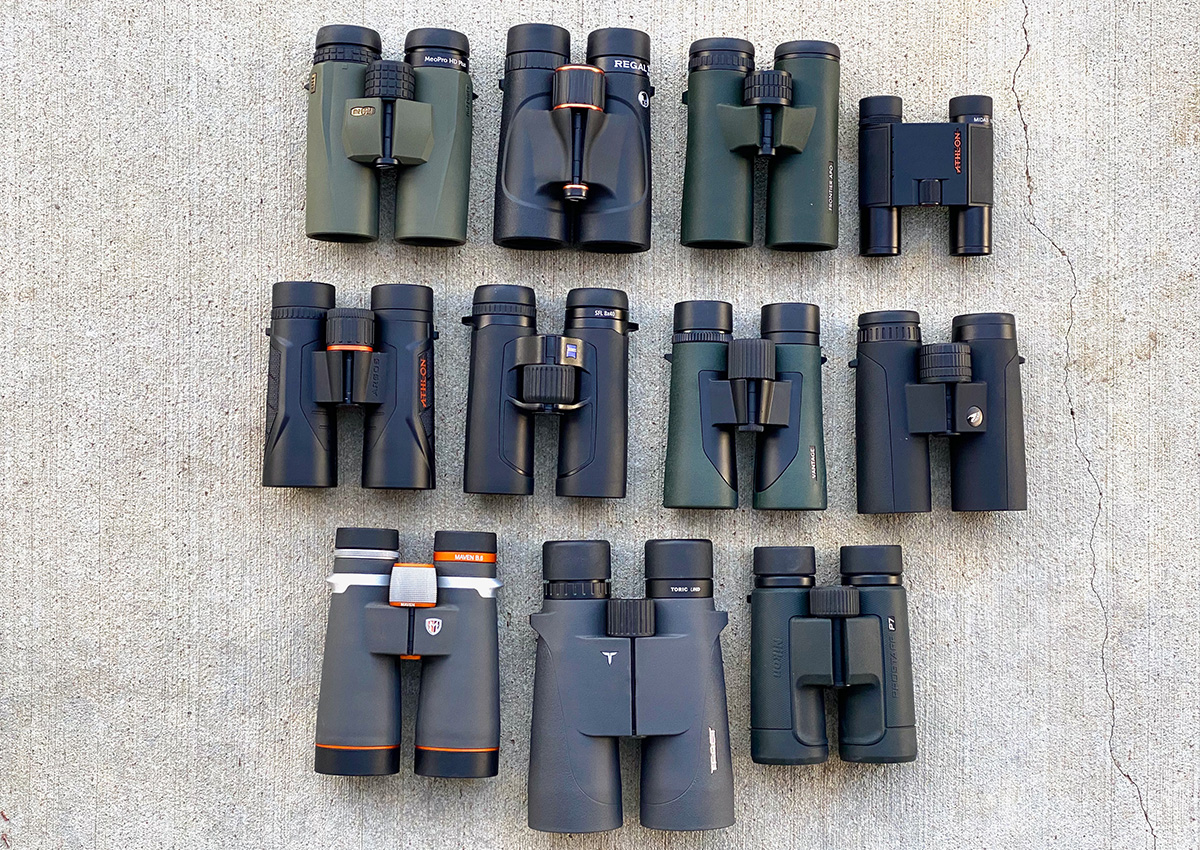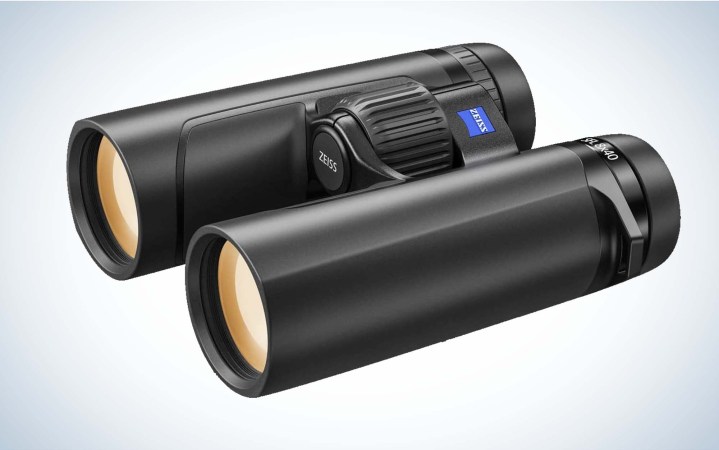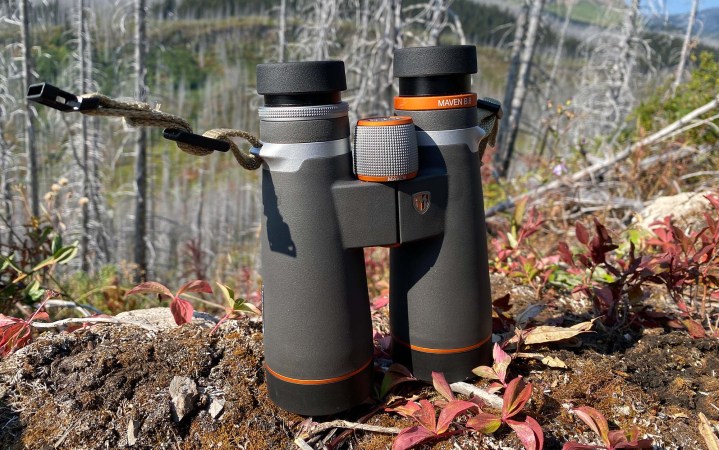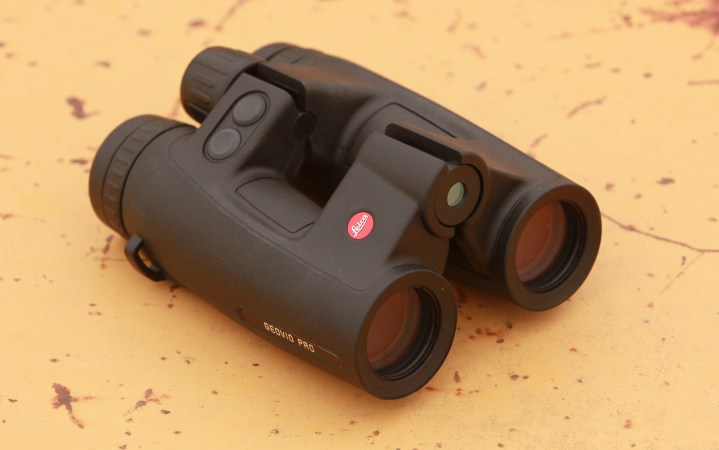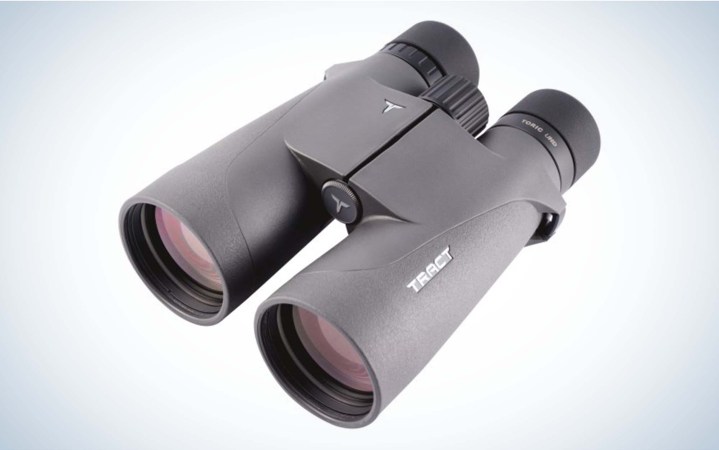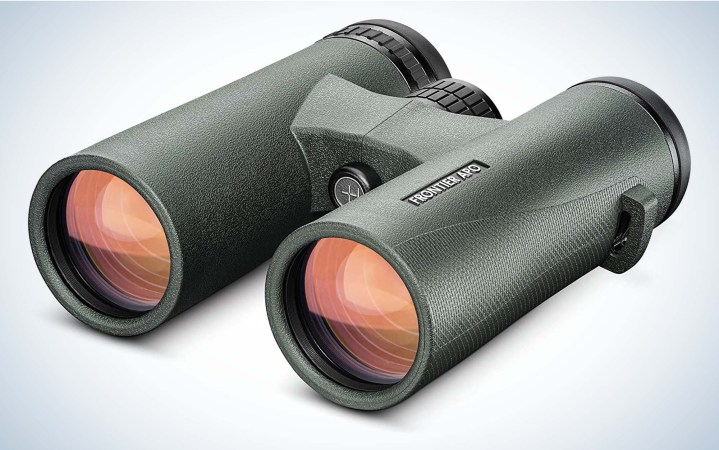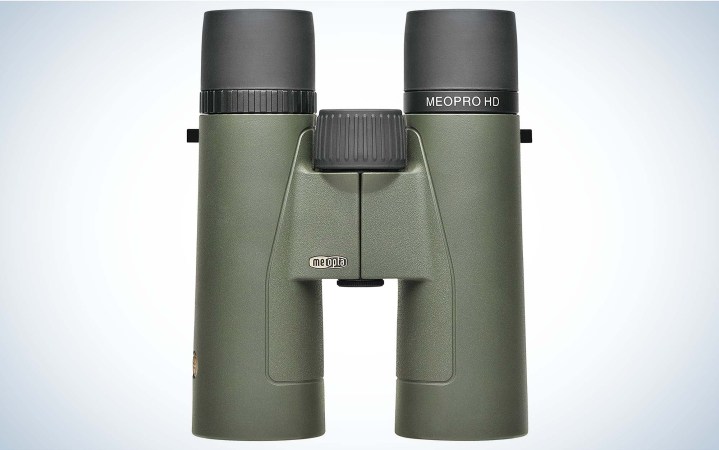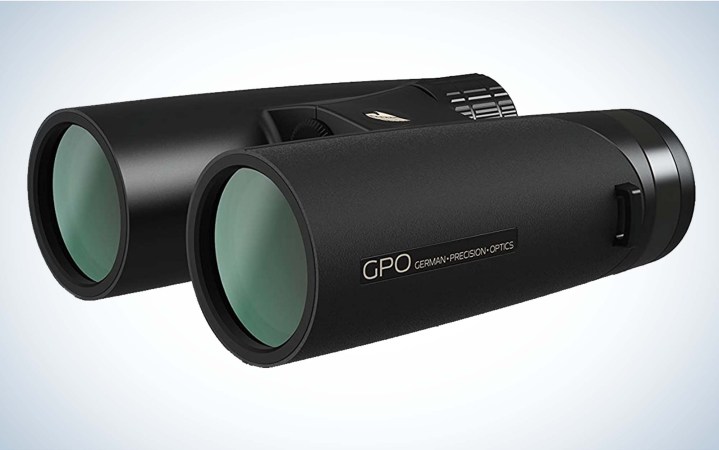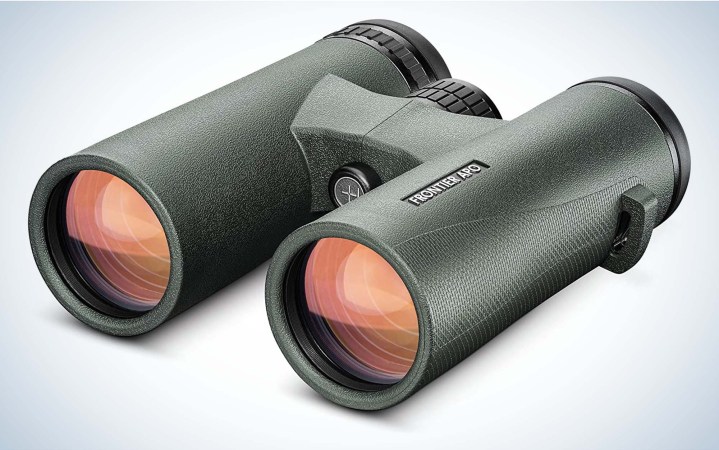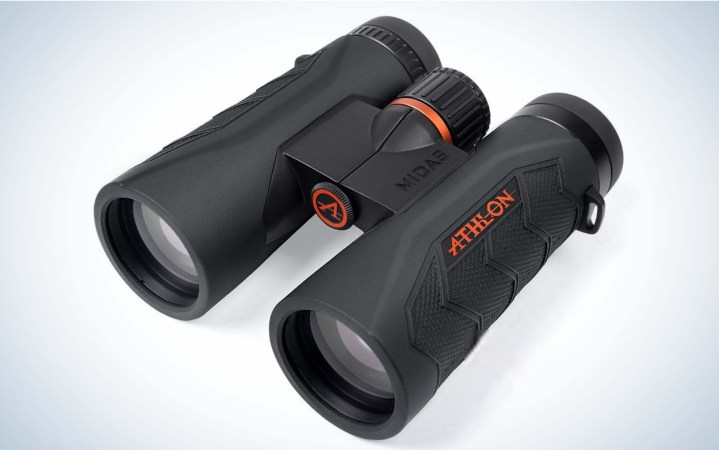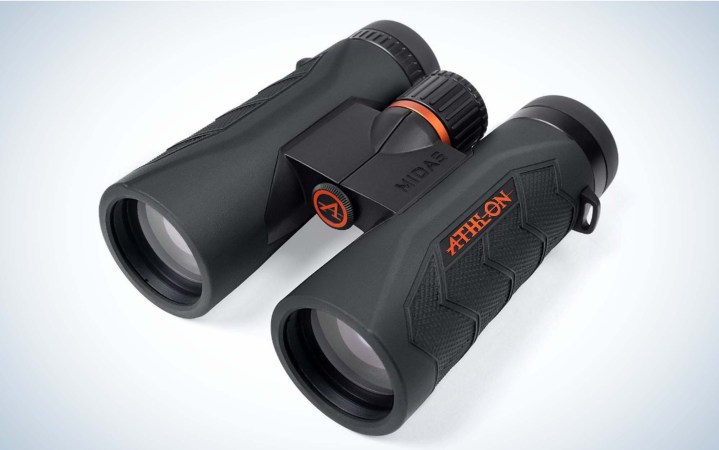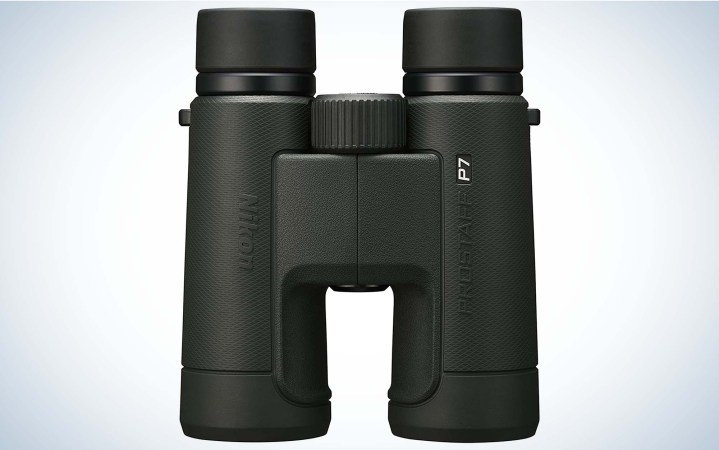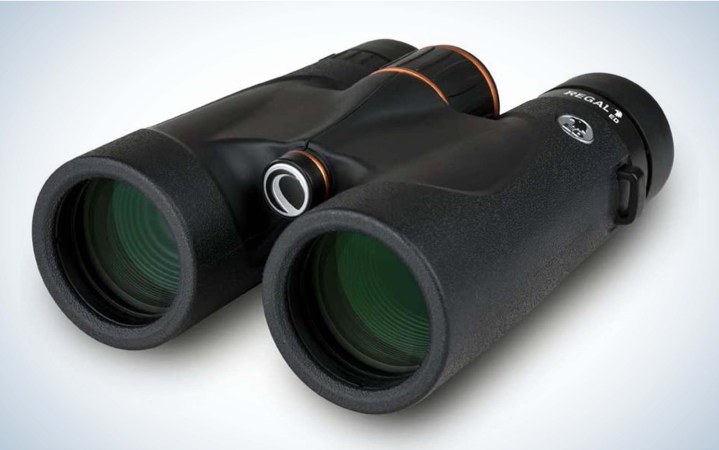We may earn revenue from the products available on this page and participate in affiliate programs. Learn More ›
Most optics brands are busy not reinventing their binocular designs. Instead, they are filling out their product lines to include 15-power models or maybe a slimmed down 32mm, while putting most of their manufacturing and marketing horsepower into riflescopes and electro-optics, the integration of traditional glass with lasers and computational software.
In fact, most submissions to Outdoor Life’s 2022 binocular test are derivative, or just updates on a design we’ve been seeing in the market for years.
Zeiss is bucking that trend with its introduction of a revolutionary new binocular, one that’s far lighter, but also brighter and more ergonomic, than its previous flagship. The Zeiss SFL40, an 8×40 marvel, is so much better than other 2022 binocular introductions that it really wasn’t a question of whether the Zeiss would win Outdoor Life’s optics test, but how the also-rans would rank in terms of their attributes. This review of the year’s best binoculars may not have numerical rankings, but the order in which these products are listed represents their relative score.
- Editor’s Choice: Zeiss SFL40 8×40
- Great Buy: Maven B.6 12×50
- Best Rangefinding Binocular: Leica Geovid Pro 32 10×32
- Best for Tripod Glassing: Tract Toric UHD 15×56
- Best for Whitetail Hunting: Hawke Frontier APO 8×42
- Best Entry-Level: Meopta MeoPro HD Plus 10×42
- Best for Mule Deer Hunting: GPO Passion ED 10×42
- Best Budget: Hawke Vantage 8×42
- Athlon Argos G2 UHD 10×42
- Athlon Argos Midas G2 UHD 10×25
- Nikon Prostaff P7 10×42
- Celestron Regal ED 10×42
How We Tested the Best Binoculars for Hunting
We test binoculars the way you use them—by subjecting them to the rigors and insults of the field. That means dusty days in a pickup and low-light conditions when game is most likely to be visible and viewing conditions are at their most challenging.
For starters, we measure the field of view, eye relief, weight, and other specifications to confirm claims of manufacturers. Then we take each model on a hike that mimics conditions of a hunt. We strap the binoculars in a chest harness and use them in a variety of terrain and light conditions. Then, we cross fences with them, and often drag them through dusty uplands.
We then mount them on a tripod and measure their optical resolution, or how finely they render details. The raw resolution score is divided into their objective lens size to determine an adjusted resolution score. We then take the entire field to our low-light lab, a patch of Montana prairie where we measure their ability to see into the descending darkness, scoring their performance against the rest of the field. We do this on multiple nights—with different testers behind the lenses—and then average the results.
Our other assessments are more subjective. Our test team is composed of five hard-core Montana hunters and shooters, and each one spends a week with the binos in the field, judging its ergonomics, its durability, and its style, and comfort. Their scores are admittedly subjective, and we often disagree on conclusions. But we don’t know a better way to evaluate the non-analytic considerations that most of you use to determine which is the best binocular for your use.
The binocular with the highest overall score wins our Editor’s Choice award—this year it went to the Zeiss SFL40. But we also assign a price/value score to each submission. That’s our opinion of how much of a bargain or a rip-off each binocular is. The optic with the highest price/value score wins our Great Buy award. This year that nod goes to Maven’s capable B.6.
Best Binoculars for Hunting: Reviews & Recommendations
Editor’s Choice: Zeiss SFL40 8×40
Editor’s Choice
Zeiss SFL40 8×40
Key Features
- Weight: 22.6 ounces
- Field of View at 1,000 Yards: 420 feet
- Best close-focus in the test
- Lightweight magnesium chassis
- Oversized SmartFocus wheel
Pros
- Brightest binoculars in this year’s test
- 20 percent lighter than 8×42 Zeiss Conquest
- Excellent color fidelity
- Thinner lens elements and shorter optical path cuts both weight and length
Cons
- Lightweight build may lead to durability issues
A capable new flagship from Zeiss, the SFL40 has thinner lenses to reduce weight by 20 percent, a big luxurious focus wheel placed exactly where your finger falls, and the brightest glass in our test. I can’t believe I’d say this about an $1,800 binocular, but it’s a raging bargain.
A ground-breaking design, the SFL40 combines a featherweight frame with a new optical prescription that uses thinner, more closely positioned lenses to deliver a bright image in a very lightweight and compact package. The single-hinge design and oversized focus wheel make one-hand operation a cinch. Because the focus zooms from 1.5 meters to infinity in just 1.4 revolutions, it’s easy to cover the landscape quickly, even with gloved hands.
The SFL40 fits nicely into Zeiss’s product line between the very good Japanese-made Conquest line and the flagship Victory line. Priced just above the Conquest, the SFL40 (also manufactured in Japan) should appeal to hunters and birdwatchers looking for an investment-grade binocular under $2,000.
Other noteworthy attributes: the 3-position tapered eyecups, beefy hinge (Zeiss calls it the DoubleLink Bridge), and grippy open barrels. The SFL40 is also available in a 10×40 variation. The 8×40 configuration of our sample took the top score in our resolution evaluation and charmed our testers with its stunning image, thoughtful ergonomics, and extremely light weight. It also gave the big 56 and 50mm submissions a run for their money in our low-light test. Simply stated, this is the best walk-about binoculars we’ve ever tested, one that you’ll hardly feel around your neck.
Great Buy: Maven B.6 12×50
Great Buy
Maven B.6 12×50
Key Features
- Weight: 30.7 ounces
- Field of View at 1,000 Yards: 289 feet
- Tripod adaptable
- Textured aluminum focus wheel
- Magnesium chassis
Pros
- Beefy single hinge and open barrel facilitate one-hand operation
- Stylish charcoal armor with orange-and-silver accents
- Quality Japanese glass and construction
- Direct-to-consumer brand cuts out retail pricing
- Also available in 10×50 configuration
Cons
- Large chassis size may not fit in standard harness pouches
- At nearly 2 pounds, it’s a hefty binocular
A big, serious binocular designed for Western hunters, the B.6 provides more magnification than a standard 10×42 without the heft of a 15-power. Smart ergonomics make it easy to hold, and excellent glass delivers a bright, crisp image.
Some readers may question why we gave a $1,050 binocular our Great Buy award, which typically goes to raging bargains that cost a fraction of a grand. Our take is that this is a great deal, especially considering the massive optical horsepower of this 12-power binocular. Given the build, quality of the glass, and smart ergonomics, we’d expect this optic to be priced closer to $2,000.
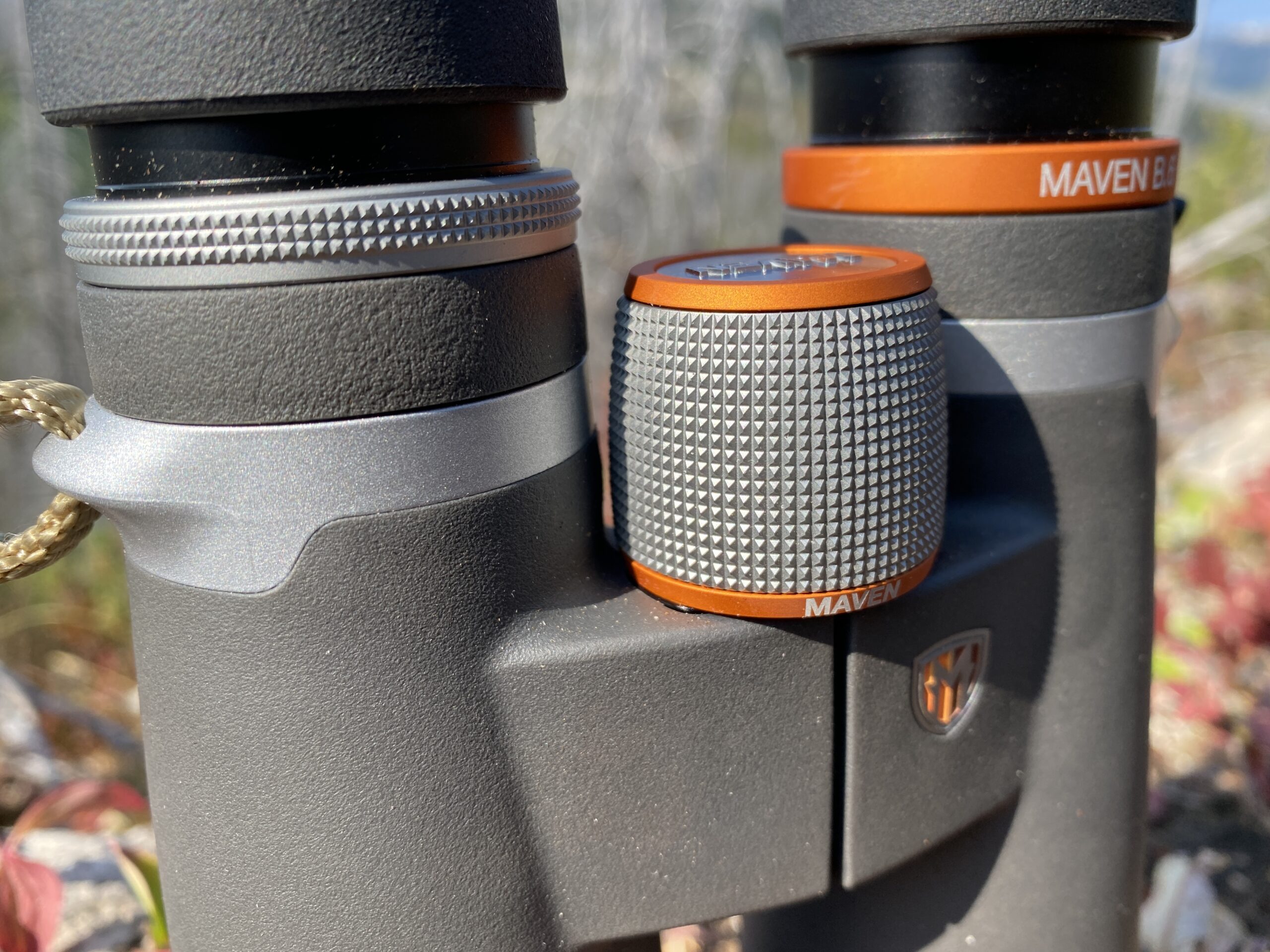
The B.6 occupies a smart place in the market, halfway between the crowded field of capable 10x42s and the big, purpose-built 15×56 binoculars that require a tripod mount in order to use effectively. Maven’s 12×50 is still portable enough to carry, balanced and grippy enough to hand-hold without shaking, and offers enough optical reach to count antler points at long distances. This is Maven’s premium product, a sized-up version of its excellent B.1, but without the massive 56mm objectives of the B.5. If you don’t want all the magnification of the 12-power that we tested, the 10×50 is a great choice for just about any western hunter looking for reach and portability. It’s also extremely bright, finishing just behind Tract’s 56mm binocular in our low-light test.
When you consider Maven’s lifetime warranty and excellent customer service, we felt like the B.6 represented a remarkable value as well as a top performer.
For more info, read our full review of the Maven B series lineup.
Best Rangefinding Binocular: Leica Geovid Pro 32 10×32
Best Overall
Leica Geovid Pro 32 10×32
Key Features
- Weight: 29 ounces
- Magnification: 10-power (also available in 8-power)
- Objective Lens Diameter: 32mm
- Bluetooth connectivity
- Tethers to Leica’s Ballistics mobile app
- Line-of-sight, angle-adjusted, and ballistic ranging modes
- Range: 10-2,600 yards
- Compass provides target headings
- Built-in Applied Ballistics Ultralite database
Pros
- Full range of modes
- One-hand operation
- Onboard weather center
- Pairs with digital maps for tracking assist
- Extremely portable
Cons
- Inscrutable display typography
- Loading personal data is tedious
- Diopters loosen with use
Simply the smartest, most technologically advanced rangefinding binocular we’ve tested, it has the added attributes of best-in-class glass and coatings. And it’s sized right for hunters. We ran out of superlatives to describe the attributes of this tremendous rangefinding binocular from Leica.
Let’s start with the size. Unlike the monster frames of many of its peers, the Geovid Pro 32 sized down its physical dimensions while upping its performance. The open-barrel build is easy to use with a single hand and fits in most binocular harnesses. The clear, distortion-free optics are what you’d expect from this leading European brand. But it’s the digital guts of the Pro 32 that make this a game-changing device. The Leica comes preloaded with Applied Ballistics’ Ultralite ballistics software, which provides bullet-specific drop data out to 875 yards. If you want to use these trajectory curves beyond that distance, you’ll have to invest in Applied Ballistics’ Elite library for an additional cost.
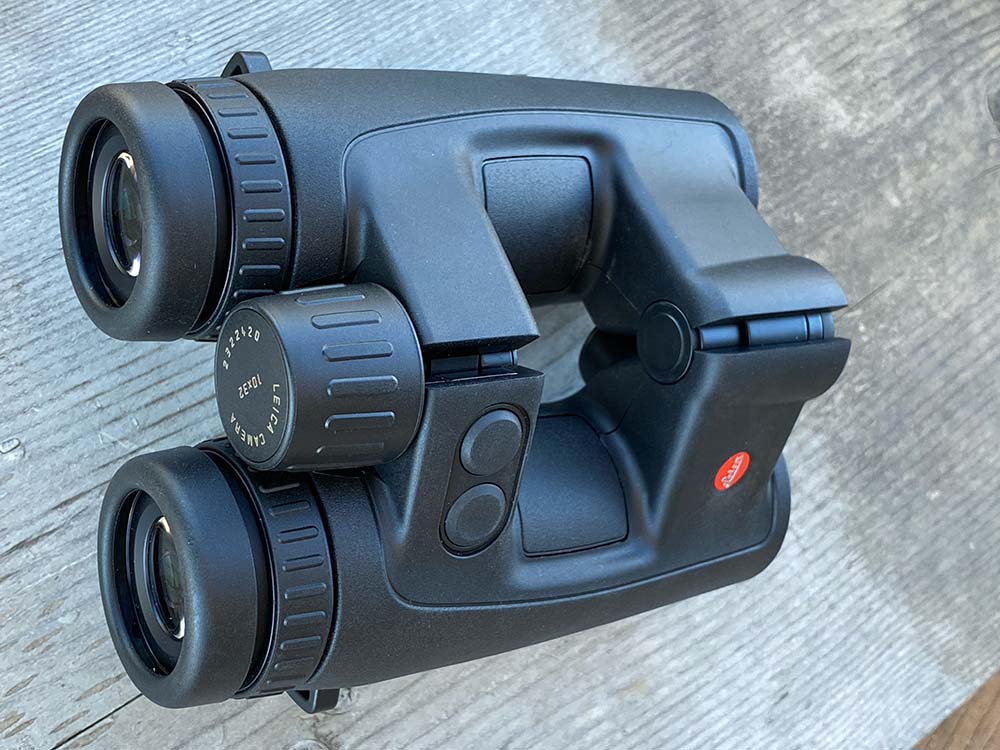
The Pro 32 also links via Bluetooth to Leica’s very good (and thankfully updated) Leica Ballistics app, which allows users to import custom gun profiles to the unit. The elevation corrections can be expressed in MOA, Mils, ¼ MOA, .1 or .05 Mil click values, and in either centimeters or inches. The Geovid also has an onboard weather center that uses temperature, elevation, and atmospheric pressure to recommend a very precise custom shooting solution. In short, it makes every hunter a better shot.
But that’s only the upper strata of the Leica’s capabilities. It also links to digital mapping services so that you can chart where you took the shot, where the target was on the landscape, and use those waypoints to track an animal. In case you lose connectivity, the Geovid has a built-in compass that will guide you home. That compass also makes this a badass tool for target and shot spotters at long-distance shooting competitions, making this the ultimate long-range hunting and shooting aid that is also a very capable binocular, even when the battery dies.
Read my colleague John Snow’s deep dive into the field attributes of the Geovid Pro 32.
Best for Tripod Glassing: Tract Toric UHD 15×56
Best for Tripod Glassing
Tract Toric UHD 15×56
Key Features
- 43.8 ounces
- Field of View at 1,000 Yards: 215 feet
- Premium Schott high-transmission glass
- Fiberglass-reinforced polycarbonate chassis
- Locking diopter
Pros
- Excellent grade of glass
- Direct-to-consumer model cuts out retail pricing
- Durable full-length center hinge
- Comfortable tapered eyecups
- Pebbly armor is easy to hold
Cons
- Undersized focus wheel
- Disappointing close focus
The only super-sized binocular in this year’s test, the 15-power Tract brings excellent glass, flare-taming coatings, and a durable build to task. The Toric delivers the best performance when mounted on a hunting tripod, but it’s light enough that you can hand-hold it with ease.
Fifteen-power binoculars are not for everyone, but for those who use them—Western hunters who pick apart distant landscapes for hours at a time—there’s no alternative. The configuration offers 50 percent more magnification than a standard 10-power, and the both-eyes-open viewing isn’t nearly as fatiguing as squinting through a spotting scope. The Tract is a very capable member of this super-sized fraternity, and brings a better high-transmission class than many of its peers while still remaining affordable for most serious hunters.
Tract’s direct-to-consumer business model allows for savings, and the Toric joins a family of bright, durable, and versatile binoculars. The Schott high-transmission glass delivers a bright and distortion-free image, as expected given its huge objective lenses, taking top honors in the low-light portion of our test. Testers appreciated the weight-saving and vibration-taming attributes of the polycarb chassis, and for those who questioned the durability of the lightweight composite, Tract offers a fully transferable lifetime warranty, further building the value proposition of this big binocular.
Best for Whitetail Hunting: Hawke Frontier APO 8×42
Best for Whitetail Hunting
Hawke Frontier APO 8×42
Key Features
- 26.1 ounces
- Field of View at 1,000 Yards: 426 feet
- Magnesium-alloy chassis
- 6.6-foot close focus
- Single-hinge, open-barrel design
Pros
- 5.6-inch height is super compact
- Comfortable tapered eyecups
- Textured focus wheel easy to turn
- Hawke’s best class of glass
- Widest field of view in our test
- Ships with premium zippered case
Cons
- Glass not on par with other premium binos
- Lifetime warranty not transferable
A surprisingly stylish and optically sharp binocular, it’s sized right for either treestand hunting or walk-about stalking tasks. Built around a class of extra-low dispersion glass with premium coatings, the optical performance of this binocular is beyond what we’ve seen from previous Hawke submissions. The image is bright and noticeably wide thanks to field-flattening design. We especially liked the nice manners of the Frontier APO; its ergonomics make one-handed operation a cinch, and it balances nicely around the neck and in hand. We especially like the textured focus and diopter wheels and the solid-state feel of the magnesium chassis.
Compared with Hawke’s Vantage binocular—also in this year’s test—this is a huge step up in both quality and performance and is capable of handling just about any deer-hunting tasks. At about $800, it’s not an entry-level binocular, but its quality build, European styling, and components should make it a solid performer.
Best Entry-Level: Meopta MeoPro HD Plus 10×42
Best Entry-Level
Meopta MeoPro HD Plus 10×42
Key Features
- 22.9 ounces
- Field of View at 1,000 Yards: 335 feet
- Magnesium-alloy chassis
- Fluoride glass
- Highly textured controls
Pros
- Good value for the price
- Ships with premium wool case
- Also available in 8×56 configuration
- Premium glass of high-definition glass
- Solid center-hinge design
Cons
- Angular contours not especially comfortable
- Narrow field of view compared with peers
With a ton of value for the price, this redesigned binocular from the Czech-based company offers good glass in a durable package and makes a solid beginning binocular or a step up from an el-cheapo model. While we weren’t especially blown away by the image or handling of this reliable binocular, our testers felt the price was attractive considering the glass, durability, and reputation of Meopta. Priced south of $500, the MeoPro HD Plus should provide years of trouble-free glassing.
The MeoPro HD Plus is a redesign of a family that’s been a staple of Meopta’s product lineup for years, but touches include a more angular external contour, highly textured focus and diopter controls, and nicely tapered 3-position eyecups. It combines European styling with decent glass and an appealing price. Testers dinged the MeoPro on its spongy focus wheel and clunky handling, but liked the clear, distortion-free glass and durability of the magnesium-alloy frame.
Best for Mule Deer Hunting: GPO Passion ED 10×42
Best for Mule Deer Hunting
GPO Passion ED 10×42
Key Features
- Weight: 26 ounces
- Field of View at 1,000 Yards: 340 feet
- Magnesium chassis
- Extra-low dispersion glass in objective lenses
Pros
- Ships in premium zippered case
- Nice balance and heft
- ED glass in objective lenses
- Available in desert sand, dark brown earth, and green
- Tapered aluminum-coated eyecups
Cons
- Focus wheel is spongy
- Image is good but not memorable
Its combination of durability and European styling make GPO’s mid-level binocular a good fit for a walk-about Western hunter. Decent image and pleasing balance add to its versatility. GPO has done a nice job of positioning its brand as aspirational for Western hunters. It has a full range of big binos suited for Coues deer hunting, and its products are far more affordable than premium European models. The Passion ED fills a needed mid-level price and performance point, sandwiched between the more pedestrian Spectra and the premium Passion HD series. Extra-low dispersion glass in the front lenses gives the Passion ED a little kick in brightness and clarity.
We liked the handsome styling and responsive manners, and the accessories that include a premium zippered case and cushioned neck strap, are a nice added value. The diopter and eyecups are well done; our only gripe with the controls was the mushy focus wheel. But for a compact (it’s only 5.7 inches high) binocular that will deliver years of service, this is a good choice for a hunter who plans to cover a lot of ground.
Best Budget: Hawke Vantage 8×42
Best Budget
Hawke Vantage 8×42
Key Features
- Weight: 19.6 ounces
- Field of View at 1,000 Yards: 367 feet
- Polycarbonate frame
- Tripod adaptable
- Oversized focus wheel
Pros
- Center-hinge design allows for one-hand operation
- Decently bright image
- Affordable price
- Lifetime (non-transferable) warranty
Cons
- Significant edge distortion
- Questionable durability
Don’t expect a world-class image from this entry-level binocular, but at around $150, it allows beginning hunters and shooters to get in the game. Not every binocular needs to hail from Europe and cost as much as your first car. There’s plenty of room in the market for more affordable optics, and this entry-level model from Hawke is a good choice for those looking for a decent binocular for a wide range of hunting and wildlife viewing.
The Outdoor Life test team concluded that the image was better than expected, especially in broad daylight, and we liked the responsive eye cups that fit most brows comfortably. We detected some significant edge distortion and some flaring, probably because of poor optical coatings, but the center of the image is crisp and bright. We also expected a wider field of view. In low light, the Vantage’s shortcomings reveal themselves; the image gets dark and murky earlier than its peers in this year’s test.
And the testers questioned the durability of the moving parts and the polycarbonate frame. But Hawke has an excellent lifetime warranty that should relieve anyone concerned about investing in the Vantage.
Athlon Argos G2 UHD 10×42
Athlon Argos G2 UHD 10×42
Key Features
- Weight: 25.5 ounces
- Field of View at 1,000 Yards: 319 feet
- Magnesium-alloy chassis
- Accessible price
- Oversized focus wheel
Pros
- Priced around $300
- Aggressively textured armor
- Also available in 8-power
- Better-than-expected image quality
Cons
- Flimsy feel to moving parts
- Relatively narrow field of view
Not every binocular needs to—or should—join you in the field, and this is one that’s best suited for the dashboard or console of a pickup, ready to deploy to read a distant sign or admire a roadside buck. A derivative design, testers reckoned that the Athlon was produced on the same line that gave us the Celestron. They have a similar look, feel, and performance. That’s not a bad thing; the Athlon offers a ton of value for the price, right around $300. The image is better than we expected, but really shows its shortcomings mainly in low-light conditions. The polycarb body should be durable in a wide range of conditions. We were, however, disappointed in the relatively narrow field of view.
Our other dings were mechanical. Its moving parts are a little loose, and the eye-forward balance makes it hard to use with a single hand. But for a decent optics to throw in the pickup and use when you need a better view of wildlife or a football game, this binocular should provide years of satisfying service. And, if there’s ever a problem, Athlon’s legendary warranty and customer service is a consolation.
Athlon Argos Midas G2 UHD 10×25
Argos Midas G2 UHD 10×25
Key Features
- Weight: 8.3 ounces
- Field of View at 1,000 Yards: 285 feet
- Magnesium chassis
- Double-hinge, batwing design
- Super compact
Pros
- Extremely light and compact
- Goes anywhere
- Excellent lifetime warranty
- Responsive controls
Cons
- 10-power is a bit too much magnification for the small frame
- Image darkens quickly in low light
We had so many full-size binoculars in the field, we wanted to test a super-compact, shirt-pocket model. This is a nimble, go-everywhere travel optic that’s about the size of a deck of cards. This is a nice rendering of a tough design. In order to pack so many moving parts and durability in a package small enough to tuck into a shirt pocket, controls have to be sized down, and some super-compact binoculars have such teensy moving parts that they’re hard to manipulate with man-sized hands. But Athlon has done a nice job of delivering a compact model with extreme usability.
It’s hard to compare the optical performance of such a wee binocular with big 10×42 and larger optics, but the Athlon fell out of our low-light test not long after legal light, and testers complained that the image looked grainy even in broad daylight. Still, it’s a great choice for turkey hunting or for a travel optic or to keep in a glovebox to deploy any time you need a little optical reach.
Nikon Prostaff P7 10×42
Nikon Prostaff P7 10×42
Key Features
- Weight: 21.2 ounces
- Field of View at 1,000 Yards: 367 feet
- Chassis made of fiberglass-reinforced polycarbonate resin
- Premium Nikon coatings
- 3-position eyecups
Pros
- Extremely lightweight
- Polycarb body absorbs vibrations
- Appealing price
- Textured and contoured armor
Cons
- Plasticky feel
- Not tripod adaptable
Light, bright, and durable, this latest model from Nikon brings decent glass, a very accessible price, and a featherweight frame that goes just about anywhere. One of the powerhouses of the optics industry, Nikon has quietly distanced itself from hunting- and shooting-related gear. It no longer manufactures riflescopes, and it hasn’t focused its significant electro-optics on the sporting side of its business. But this excellent binocular has plenty of talent for the field—or for traveling in the mountains, water, or the world’s backroads. Its strongest suits are its extremely light weight and its very good glass for the price.
The P7 comes to the market at under $200, a price that makes a case for the Prostaff as a good choice for an entry-level hunter, and it gave the Maven a run for our Great Buy award. The polycarb chassis gave testers a little bit of pause owing to its flimsy feel, but it’s nimble and responsive in the hands of both young and old hunters who don’t want to fight the weight of a metal-framed binocular. The image is bright and sharp, and we liked the snappy eyecups and the velvety focus. And with a lifetime (though non-transferable) warranty, any durability concerns should be adequately addressed by Nikon.
Celestron Regal ED 10×42
Celestron Regal ED 10×42
Key Features
- Weight: 27.1 ounces
- Field of View at 1,000 Yards: 340 feet
- Alloy chassis
- Extra-low dispersion glass in objective lenses
- 4.9-foot close focus
- Ships with premium zippered case and harness
Pros
- Durable center-hinge design
- Field-flattening lenses
- Oversized focus wheel
- At around $400, accessible price
Cons
- Focus wheel and hinge are sloppy
- Bronze accents are a little blingy
While this brand doesn’t have a ton of hunting DNA, its long history in celestial observation has provided plenty of context and talent for this versatile binocular. The extra-low dispersion glass used in the objective lenses is easily the best part of this binocular from a brand better known for its celestial observation equipment. That’s not to say that a binocular has to be covered in camo to be considered suitable for hunting, only that a company that builds star-gazing telescopes can be forgiven for building an optic that may not be as field-worthy as others in the test.
The moving parts of the Regal ED could use some tightening, from the focus wheel to the hinge to the eyecups and diopter wheel. We don’t question the durability of this full-sized binocular, and testers were impressed with the edge-to-edge clarity and brightness of the image it delivers. We can recommend it as a solid choice for the back deck or the console of your pickup. The premium zippered nylon case and binocular harness add to the significant value.
Things to Consider Before Buying Binoculars for Hunting
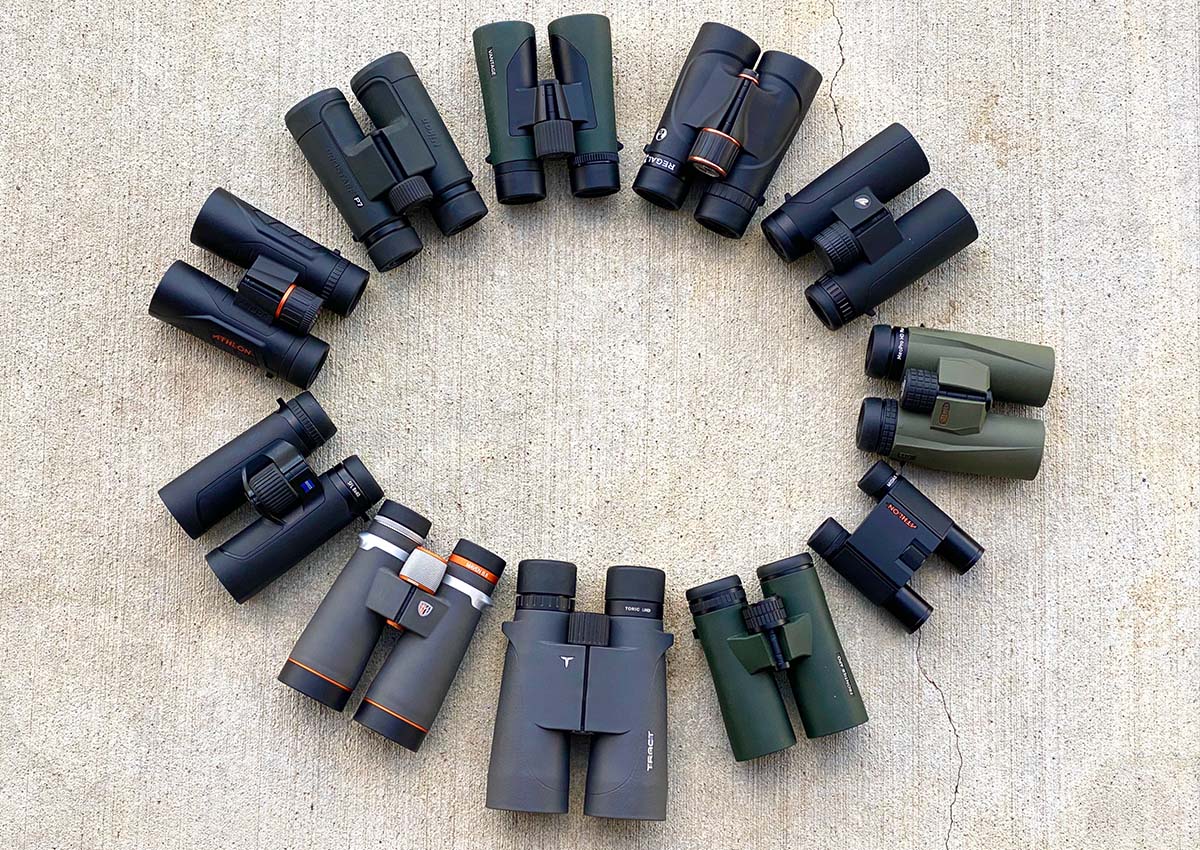
When you’re in the market for a binocular, your first consideration is how you’ll use it. If you will mostly be up in a stand overlooking a whitetail food plot, then you don’t need a 12- or 15-power large-framed binocular. Rather, you need an 8-power binocular built on a 32 or 40mm frame. Similarly, if you intend to perch on the rim of a Southwest canyon and glass for Coues deer, then you don’t want a compact, low-power binocular; you want a big 15×56 model.
Most of the binoculars in our test are 10×42 models, designed for a wide variety of tasks, from general hiking and wildlife observation to backcountry hunts where ounces become pounds with distance and elevation. This configuration finds the sweet spot of versatility, which is why you see so many of our submissions in that particular magnification and objective lens size.
Consider the quality of glass. The industry likes to throw around terms such as high-transmission glass or high-definition glass that really have no consistent meaning. Generally, if a binocular contains fluorite glass, you can expect a brighter, more perfect image than one that contains standard glass. Similarly, binoculars with extra-low dispersion ( ED) glass generally are clearer than those with HD (high-definition) or HT (high-transmission) glass. Note, though, that many brands that advertise high-quality glass use it only in the objective lenses, and not throughout the optical system. One easy way to check the quality of interior lenses: shine a flashlight through the objective lens (that’s the big lens on the front). If you see a pure white reflection bouncing back at you, there are uncoated interior lenses, and you can expect to get distortion and flaring when you use them in bright sunlight.
You need to consider your budget, since binoculars can cost anywhere from a couple hundred dollars to a couple thousand. And you need to consider whether you’ll be using it every couple steps—as I do—on a walk-about big-game hunt, or whether it will spend most of its time in your pack, or on a hook next to your stand.
Lastly, consider durability. Even with rough handlings, binoculars should be designed to give you years and decades of trouble-free operation, but make sure that moving parts are tight and turn with precision. If you settle on a pair of worthy candidates, then consider the brands’ warranty as the tie-breaker. Customers have come to expect that optics companies have fully transferable lifetime warranties.
FAQs
The short answer is yes. For safety, because binoculars enable you to see distant objects without pointing your gun at them and using your riflescope as a telescope is never a good idea. For ethics, to make sure of your target before shooting at it. For efficiency, because binoculars shrink distance and allow you to assess far objects without walking all the way to them. And for success, because binoculars help you see distant animals in the first and last hours of the day, when they’re most likely to be moving.
Every binocular has two numbers. The first is the magnification, or the amount of times the image is enlarged. The second is the size of the objective lens, in millimeters. The objective lens is the larger lens that points toward your target when you look through a binocular, and the larger the objective lens, the more light and detail enter the eye. Using this formula, an 8×32 binocular has 8-times magnification (or “power”) and a 32mm objective lens.
If you’re still wondering, what do numbers on binoculars mean, here are more tips. Typically, the larger the numbers, the greater the optical performance, but also the physical size of the binocular. A 6×24 binocular is small enough to fit in a shirt pocket. A 15×56, on the other hand, is so large it’s hard to hold in your hand. Hunters want a binocular that is powerful enough to see distant objects but small enough to be portable. The sweet spot for most hunters is an 8- or 10-power behind a 32 to 42mm lens. So look for models with these numbers: 8×32, 8×42, 10×42, or for light-gathering ability, 10×50.
You can spend as little as $100 or as much as $4,000 for a hunting binocular. Generally, the more money you spend, the better the binocular, but because there’s a limit to your budget, you probably want to buy the best binocular for your money. The good news is there are lots of choices in the $400-$600 range. That’s still a lot of money, but here are three things to consider:
•Warranty – Does your brand have your back? Many optics companies offer fully transferrable lifetime warranties for binoculars. That means it’s covered for repair or replacement whether you bought the optic yourself or bought it second-hand.
•Accessories – Many brands include zippered cases or harnesses with their binoculars, a savings of around $50.
•Performance – If you spend $500 or more for an optic, you want to be sure it’s going to deliver. Look for models that have high light transmission (90 percent or higher), good customer reviews, and are built for battle, with double hinges, durable armor, and controls (focus wheels and eyecups) that move with precision and authority.
Why Trust Outdoor Life?
Since 1898, OL has been a leading authority in testing and reviewing hunting gear, fishing tackle, guns and shooting equipment, and much more. We have more than a century-long history of evaluating products, and we’re now bringing that expertise to online reviews. Our editors are experienced outdoorsmen and women, and most importantly, we’re trained journalists. We prioritize field testing and objective data when reviewing products. We conduct interviews with gear manufacturers and engineers as well as outdoor experts so that our readers have an understanding of how and why a product works—or doesn’t.
Advertising does not influence our gear reviews and it never will. While we always focus our coverage on standout products—because we want our readers to be aware of the latest and greatest gear—we also cover the flaws and quirks of any given product.
Final Thoughts
Our test is of binoculars introduced in 2023 (or late in 2021), so if you don’t see your favorite model here, it’s probably because it’s been on the market for some time. We put submissions through the paces in order to find out how bright, versatile, precise, and durable these new products really are. At the end of the day, though, a binocular is like a favorite shirt; it’s a matter of personal preference. How well does it fit your face and your hands? How comfortable is it to glass for extended periods? Any binocular that’s comfortable and pleasant to use—regardless of its price or attributes—is a better binocular than one that is uncomfortable or gives you a headache. Hopefully, you’ll use this test to narrow your search and find a model that’s right for you.
- Editor’s Choice: Zeiss SFL40 8×40
- Great Buy: Maven B.6 12×50
- Best Rangefinding Binocular: Leica Geovid Pro 32 10×32
- Best for Tripod Glassing: Tract Toric UHD 15×56
- Best for Whitetail Hunting: Hawke Frontier APO 8×42
- Best Entry-Level: Meopta MeoPro HD Plus 10×42
- Best for Mule Deer Hunting: GPO Passion ED 10×42
- Best Budget: Hawke Vantage 8×42
- Athlon Argos G2 UHD 10×42
- Athlon Argos Midas G2 UHD 10×25
- Nikon Prostaff P7 10×42
- Celestron Regal ED 10×42
